Perkütan nefrolitotomide Guy taş skoru ve modifiye Clavien derecelendirme sistemi kullanılarak başarı ve komplikasyonların değerlendirilmesi
GSS, Böbrek taşı, Clavien, perkütan nefrolitotomi, komplikasyon, taşsızlık
Evaluation of success and complications using the Guy's stone score and modified Clavien rating system in percutaneous nephrolithotomy
Kidney stones, GSS, Clavien, percutaneous nephrolithotomy, complications, stone-free,
___
- 1. Thomas K, Smith NC, Hegarty N, Glasse JM. The Guy's stone score—Grading the complexity of percutaneous nephrolithotomy procedures. Urology. 2011; 77: 277–81.
- 2. Lai D, He Y, Dai Y, Li X. Combined minimally invasive percutaneous nephrolithotomy and retrograde intrarenal surgery for staghorn calculi in patients with solitary kidney. PLoS One. 2012; 7(10): 5–7.
- 3. Aras N, Kadıoğlu A, Muslumanoğlu AY, Ersay AR. Perkutan nefrolitotomi. Turk Uroloji Dergisi 1989;15:565-72.
- 4. Fernstrom I, Johansson B: Percutaneous pyelolithotomy. Scand J Urol Nephrol 1976;10.257–259.
- 5. Raman JD, Bagrodia A, Gupta A, et al. Natural history of residual fragments following percutaneous nephrostolithotomy. J Urol 2009;181:1163–1168.
- 6. Goldwasser B, John L, Carson C, et al. Factors effecting the success rate of percutaneous nephrolithotripsy and the incidence of retained fragments, J Urol 1986; 136: 358–360.
- 7. Hasun R, Ryan PC, Marberger M; Percutaneous coagulum nephrolithotripsy: a new approach. Br J Urol. 1985 Dec;57(6):605–9.
- 8. Thomas K, Smith NC, Hegarty N, Glass JM. The Guy's stone score--grading the complexity of percutaneous nephrolithotomy procedures. Urology 2011 Aug;78(2):277–81.
- 9. Ingimarsson JP, Dagrosa LM, Hyams ES, Pais VM Jr. External Validation of a Preoperative Renal Stone Grading System: Reproducibility and Inter-rater Concordance of the Guy's Stone Score Using Preoperative Computed Tomography and Rigorous Postoperative Stone-free Criteria. Urology 2013 Nov:4291–4295.
- 10. Mandal S, Goel A, Kathpalia R, Sankhwar S, Singh V, Sinha RJ, Singh BP, Dalela D.Prospective evaluation of complications using the modified Clavien grading system, and of success rates of percutaneous nephrolithotomy using Guy's Stone Score: A single-center experience. Indian J Urol. 2012 Oct;28(4):392–8.
- 11. Skolarikos A, Alivizatos G, de la Rosette JJ. Percutaneous nephrolithotomy and its legacy. Eur Urol 2005;47: 22–28.
- 12. Netto NR Jr, Ikonomidis J, Ikari O, Claro JA: Comparative study of percutaneous access for stagSegura JW, Patterson DE, LeRoy AJ, Williams HJ Jr, Barrett DM, Benson RC Jr, May GR, Bender CE. Percutaneous removal of kidney stones: Review of 1,000 cases. J Urol 1985;134:1077–1081.
- 13. Binbay M, Akman T, Kezer C, Özgör F, Erbin A, Özkuvancı U, Berberoğlu Y, Müslümanoğlu A.Y: Effect of pelvicalicieal system anatomy on success rate in percutaneous nephrolithotomy. Eur Urol 2010;9(6):605.
- 14. Pearle MS, Nakada SY, Womack JS, Kryger JV; Outcomes of contemporary percutaneous nephrolithotomy in morbidly obese patients. J Urol 1998; 160: 669–673.
- 15. Lee WJ, Smith AD, Cubelli V, Badlani GH, Lewin B, Vernace F, Cantos E. Complications of percutaneous nephrolithotomy. Am J Roentgenol 1987;148: 177–180
- 16. Lee WJ, Smith AD, Cubelli V; et al. Complications of percutaneous nephrolithotomy. AJR Am J Roentgenol 1987; 148: 177.
- 17. Segura JW, Patterson DE, LeRoy AJ: Percutaneous removal of kidney stones. Review of 1000 cases. J Urol 1985; 134: 1077–1081.
- 18. Labate G, Modi P, Timoney A, et al. On Behalf Of The Croes Pcnl Study Group. The percutaneous nephrolithotomy global study: classification of complications. J Endourol. 2011;25:1275-80.
- 19. Lam HS, Lingeman JE, Baccon M, et al. Staghorn calculi: Analysis of treatment results between percutaneous nephrostolithotomy and extracorporeal shock wave lithotripsy monotherapy with reference to surface area. J Urol 1992; 147: 1219.
- 20. Kukreja R, Desai M, Patel S, et al. Factors affecting blood loss during percutaneous nephrolithotomy: Prospective study. J Endourol 2004; 18: 715– 722.
- 21. Tefekli A, Karadag MA, Tepeler K, Sari E, Berberoglu Y, Baykal M, Sarilar O, Muslumanoglu AY. Classification of percutaneous nephrolithotomy complications using the modified Clavien grading system: looking for a standard. Eur Urol. 2008 Jan;53(1):184–90.
- Yayın Aralığı: 3
- Başlangıç: 2020
- Yayıncı: Pera Yayıncılık
Genç hastada mesane tümörü ve genetik alt yapı
Üst üriner sistem taşları tedavisinde retrograd intrarenal cerrahi deneyimlerimiz
Yasin YİTGİN, Ayhan KARAKÖSE, Ekrem AKDENİZ
Mini perkütan nefrolitotomi:yeni sistemlerin pratiğimize katkıları
Yusuf İlker ÇÖMEZ, Doğukan SÖKMEN
Doğukan SÖKMEN, Yusuf İlker ÇÖMEZ, Volkan TUĞCU
Endoskopik üriner sistem taş tedavisi sonrası ürosepsis: riski artıran faktörler
Dilek BULUT, Merve Sefa SAYAR, Ender Cem BULUT, Alper BİTKİN, Fatih BIÇAKLIOĞLU, Serhat ÇETİN, Murat KOPARAL, Kasım ERTAŞ
